Are you going to Shetland Wool Week this year? If so, can I strongly suggest you set aside a day in your itinerary for a trip to the wonderful island of Whalsay?. The Whalsay Heritage Centre is currently hosting an exhibition of the island’s fair isle knitting that will, I assure you, really blow your mind. You might have heard about this exhibition already from Ella or Hazel – indeed, since the moment I caught a glimpse of the knitwear included in it on Instagram I have been absolutely desperate to go! When I finally did so during our last Shetland trip it did not disappoint. Indeed, as a careful and comprehensive exploration of creative knitterly skill and a distinctive island aesthetic I would say its the best exhibition of its kind I’ve seen – anywhere.
Like elsewhere in Shetland, in Whalsay knitting was a way for many women to support their families (initially through truck and later as paid outworkers). From the 1920s on, fair isle knitting had become incredibly fashionable worldwide, and Whalsay knitters were kept busy with orders. But as well as knitting pre-determined designs from swatches given to them by merchants, the island’s talented knitters experimented creatively with pattern and colour, developing distinctive allover styles.
If I were to think of a “Whalsay” style of knitting, this is what springs immediately to my mind: an allover with strong diagonals, often diced in appearance, often worked over a dark background, and sometimes making use of frequent (and creatively surprising) shade changes.
This truly beautiful sleeveless vest was knitted by Mary Irvine (nee Robertson) in the 1940s. The gauge of the garment is minute and the knitting is absolutely impeccable. Mary’s bold colour scheme is far cry from the familiar blue, red and yellows of “traditional” fair isle – indeed its near-neon shades seem strikingly contemporary.
This style of knitting – using a single, tessellating motif (rather than alternating larger and smaller bands of patterning as in ‘traditional’ fair isle ganseys) was perhaps epitomised by what was known as the “Whalsay pattern.”
Here are two Whalsay lasses – Babie Jean Polson (nee Irvine) and Maggie Shearer (nee Hutchinson) – looking completely fabulous in allovers made in the “Whalsay pattern”. If you think this motif looks a wee bit familiar, that is because a vest was knitted for Winston Churchill using this pattern, and thereafter it was renamed the “Churchill pattern”. (It appears under this name in pattern directories such as Smith and Bunyan’s Shetland Knitters Notebook).
As well as an array of incredible garments, the exhibition includes photographs of Whalsay fair isle (which you can peruse via a video slide show), and a selection of notebooks and swatch collections from many of the islands’ wonderful knitters. Swatch collections are one of my favourite things ever, and those included in this exhibition were a particular treat for the eye.
As well as personal swatch collections, there are samples from a more industrial context. I wrote about the shifting commercial pressures on Shetland knitting in Yokes, and it was fascinating for me to see this embodied in the standardised star designs from which Whalsay knitters would have worked from in the 1960s, as market demand for these sweaters rose to its height.
Each colourway is identified by a different name: “cactus”, “cosmos”, “arctic”, “fjord.”
Knitting is often characterised by interestingly specific gendered divisions of labour. In 1960s and 70s Shetland, machine-knit bodies and ribs might be made by both women and men, but generally it was women only who hand-knit fair isle yokes and borders. A Whalsay exception was Magnie Irvine, whose work is seen above.
The familial and cultural connections the curators were able to draw on in putting the exhibition together is perhaps what makes it so powerful and unique. It is rare enough for hand-knitting to find its way into a collection; rarer still for those collections to retain detailed information about a garment’s provenance or history. But here you are able to examine a beautiful hand-knit allover together with a photograph that documents its wearing and its wearer. And then, turning to the comprehensive (and impressive) catalogue that accompanies the exhibition, you can read the name of the knitter who made the garment, for whom the garment was made, and details of its history. You learn that a particular gansey was knitted for a grandson, who refused to wear it, but which was later happily sported by his sister. You discover, after admiring a particular pair of socks, that Bella Arthur knitted them for Amanda Pottinger, who wore them inside her rubber boots when she went sledging. You can trace the work of some famously talented Whaslay knitters (such as Ina Irvine), and reflect on the development and achievement of an individual’s recognisable knitting style over several decades. How amazing is that? The catalogue also includes answers to some of the random questions I have found myself asking when examining an item of knitwear in a museum collection. For example, of the mixing of synthetic yarns with Shetland wool during the 1980s, I learned that Whalsay knitters did this “so that the white stayed white.”
These might seem incidental details, but they are not. Such information is really important if we are to retain and develop our understanding of hand-knitting and its history in locations like Whalsay. The more we know, the more we can really shout about the significance of hand-knitting: a craft whose cultural importance has often gone under-documented and under-appreciated because it was performed in a domestic context, largely by women.
This marvellous exhibition reveals the centrality of hand-knitting to the cultural life of Whalsay, and pays deserved testimony to the creative talent of the knitters who live and work there. Revealing how a distinctive textile aesthetic emerged and developed over the course of a century in a small, specific island context alone makes the exhibition really important, but more than that, it is also local history, family history, social history at its very, very best.
A great admirer of Missoni, I recently travelled to London to see an acclaimed exhibition . Entering the main display space, I was stunned by the overall effect of the collected garments, but deeply disappointed by the lack of ANY contextual information in the exhibition or catalogue which might have added to my understanding of the fashion house’s distinctive aesthetic. The garments were displayed on an all-but inaccessible tiered crowd of mannequins, with self-indulgent pyrotechnics of light and sound distracting from, rather than adding to, one’s appreciation. In which seasonal collection did that swimsuit appear? What might have influenced the distinctive palette of that cardigan? Who knew! I spent about an hour in that room, squinting at the detail of a garment several feet above me, trying to get a good look at it before the lights inevitably popped off and plunged me once more into darkness. It was a frustrating experience.
So I would like to say that in all respects Fair Isle Knitwear Through the Decades at the Whalsay heritage centre beat Missoni Art Colour at the Fashion and Textile Museum hands-down. I had exactly the same “WOW” reaction upon entering a space filled with stunning, colourful knitwear, but then, being drawn to an item that interested me, I could actually spend some time happily learning about where it was made, by whom, for whom, and the broader cultural and aesthetic context that had influenced its making.
So all I can say is a massive thankyou and congratulations to Linda Shearer, Amanda Pottinger and Ruby Thelma Williamson for creating and curating this incredible exhibition, which has both enriched my understanding and really inspired me. Grateful thanks, too, to the generous people of Whalsay who loaned or donated knitwear to the exhibition.
And while we are on the subject of inspiration, the exhibition concludes with the work of the island’s peerie makkers: young Whalsay lasses who love knitting fair isle, and regularly win prizes for their knitting at the local shows. In the image above you can see examples of their work, deploying their own colour choices, developing their own knitterly aesthetics. . .
I think we can say the future of fair isle in Whalsay is in good hands.
The exhibition can currently be seen in Whalsay Heritage Centre, and, due to popular demand will remain in situ for another year.


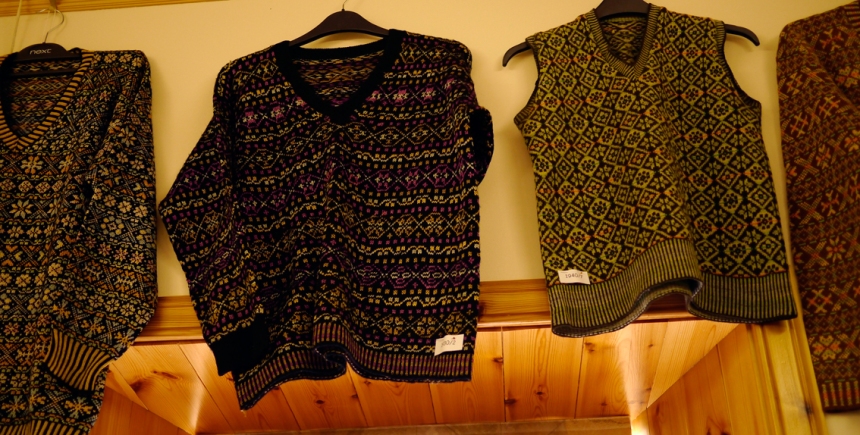
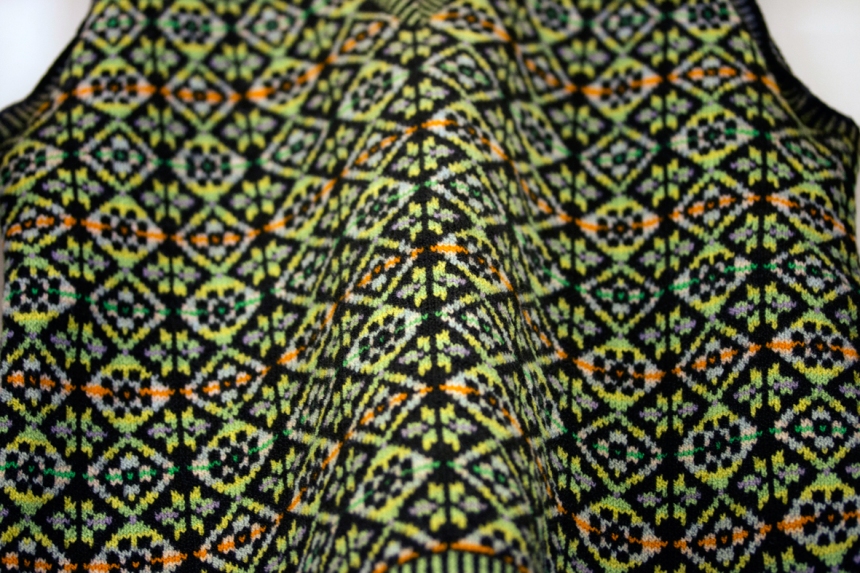
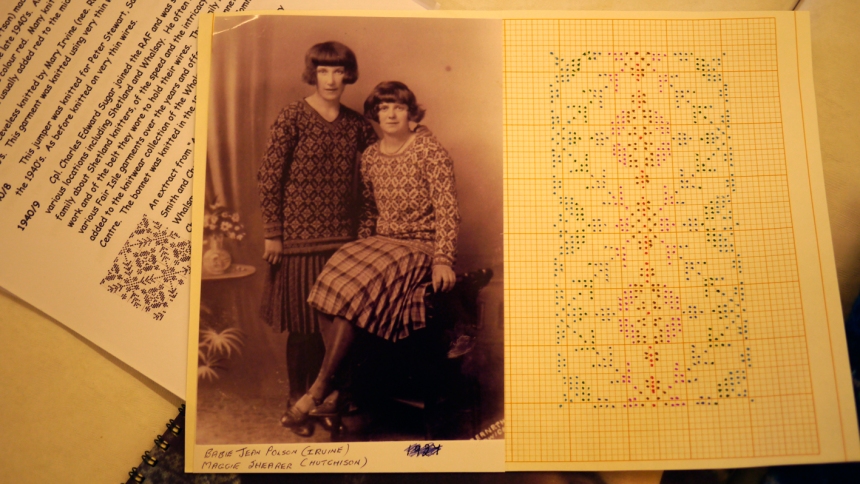
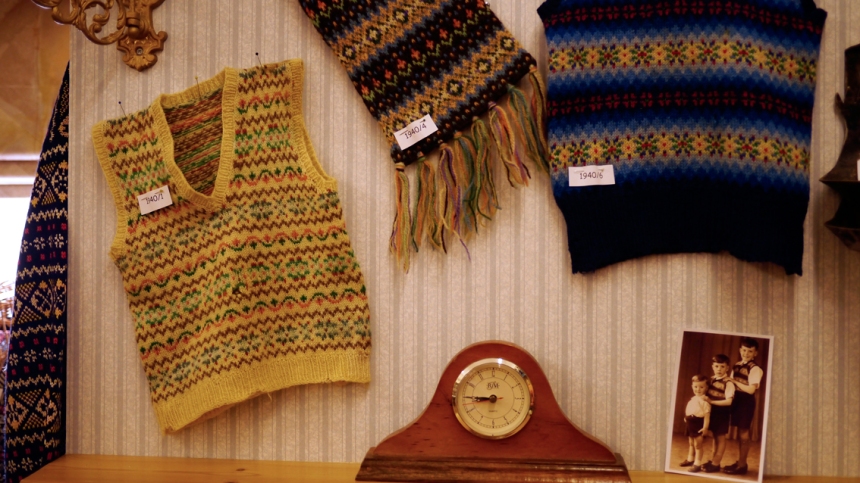
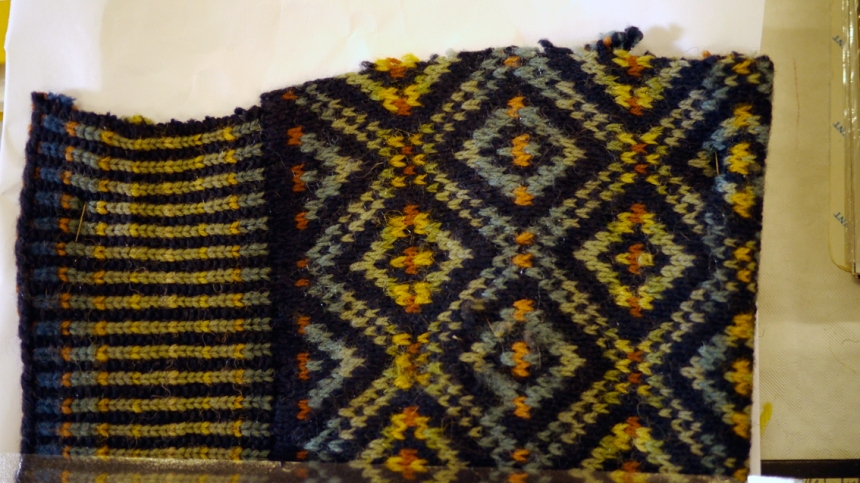

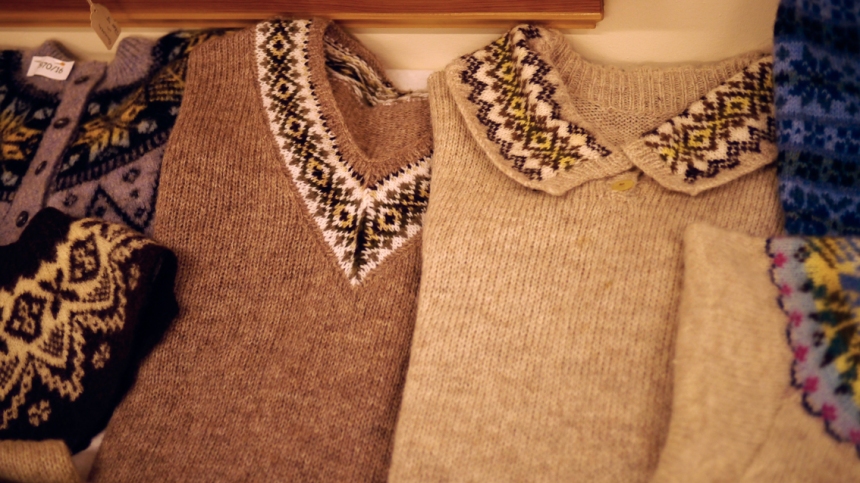

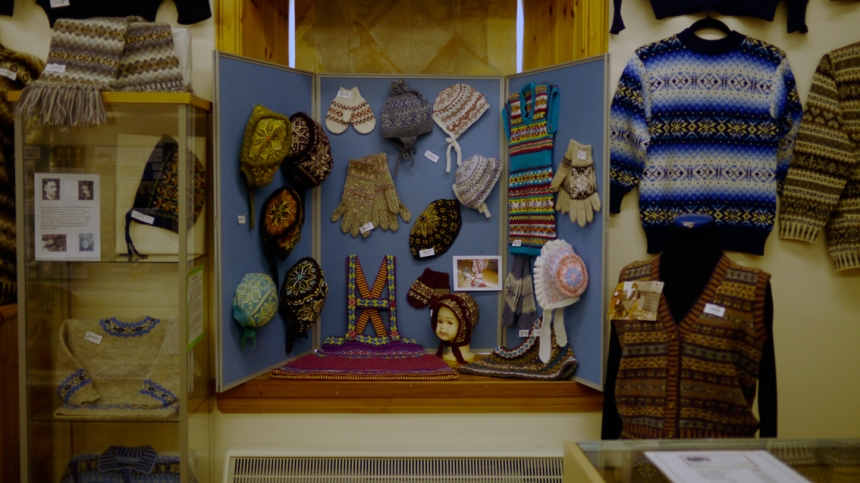

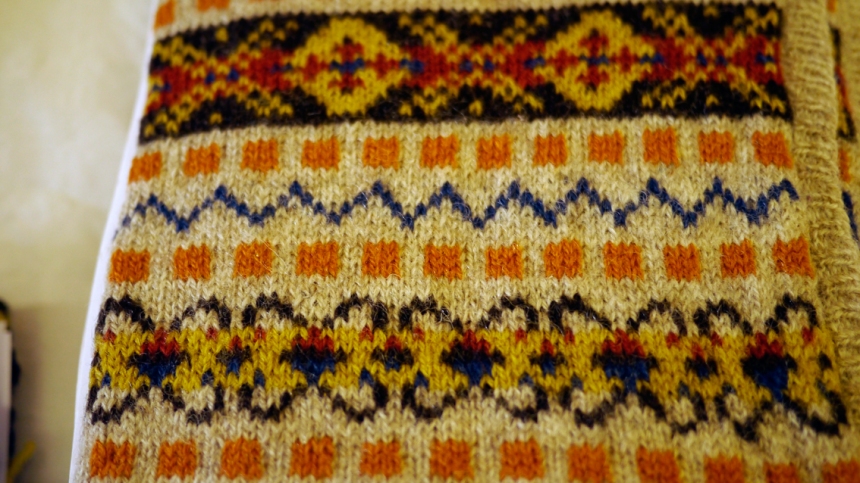
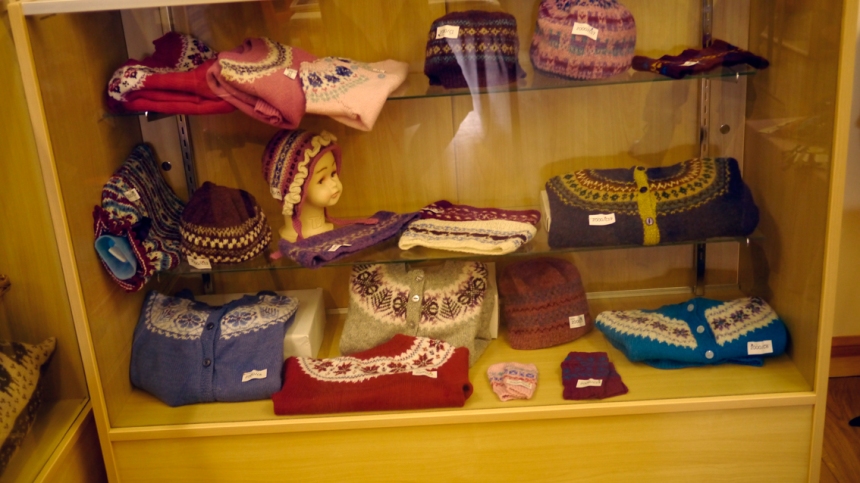
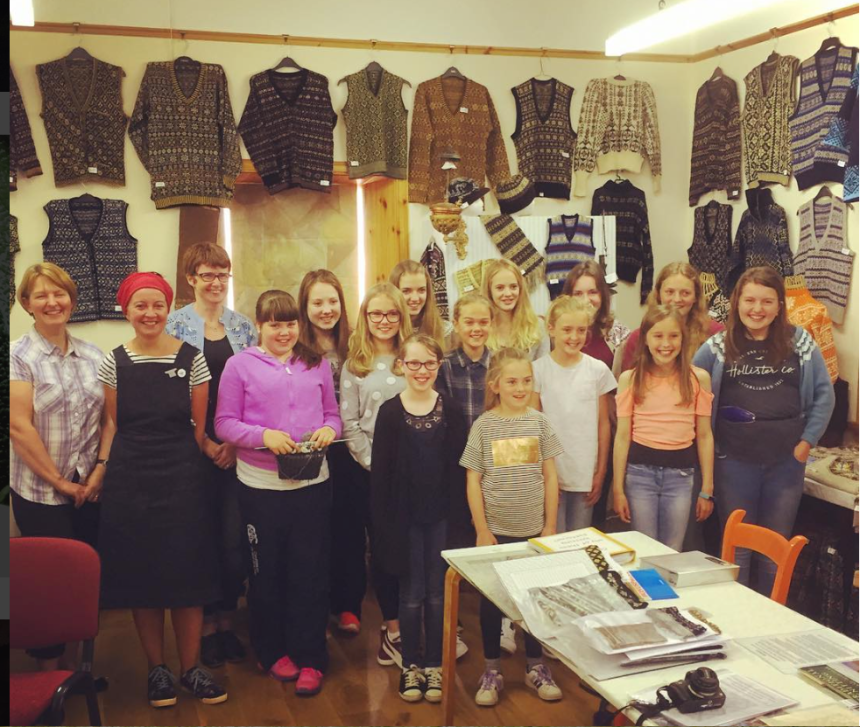
I traveled to Shetland in March of this year, and fell in love with the sound of the sea, the air, the people, all of it! I did not make it to Whalsay, but planned to next time. Having read this, Whalsay is a priority! Thank you for this wonderful, detailed post!
LikeLiked by 1 person
Thank you so much for taking your time and working so hard to produce such a brilliant book worthy post. I need to look at your patterns and make a purchase to show my appreciation! I’m so glad I found your blog. This is knitting at its finest and you’ve given me a front row seat to an event I couldn’t attend in this particular season of my life.
LikeLike
At my favorite thrift shop in Cambridge ,Ma. I died when I saw a simple waistcoat in red,blue, beige and brown for $3;00…I grabbed it as Fair Isle knits are a very favorite of mine. A very old label said
From Shetland by
Hazel Simpson of
Shetland Workshop
Gallery ~ Does anyone know of her??????
LikeLike
Hello Marion
Yes, I did meet Hazel Simpson at art college in Edinburgh. She was studying on the same course as me. I have lost touch with her as I moved .
I do not know of her current whereabouts.
Jane
,
LikeLike
I was in high school in a tony suburb north of Chicago in the 1980s when Fair Isle sweaters were all the rage, and I even worked in the local shop that sold them (so I could save up, and buy myself one per season). I think I”ve still got my beloved green fair isle sweater that I wore with green kilt somewhere in a box in my basement. At any rate, if you’re ever interested in how they were worn Stateside at that point — we all wore ours as extras in Ordinary People, layered as one did then with about four shirts, as if our high school was unheated!
LikeLike
that’s a brilliant memory,and relevant to the social/cultural theme of the exhibition – remember seeing Ordinary People when it first came out in UK, will have to check it out for fashion history!
LikeLike
I’m so glad I read about the exhibition here just a day or two before my Shetland holiday ended! Thankfully ferry times and opening times worked out for me to go on Saturday, my last day. I endorse everything you have written about it and was thrilled to find so much knitted treasure in one small place.
LikeLike
Kate, you often just leave me speechless after reading a post. The work that is showcased here is beyond stunning. I too, like so many of us knitters, love the bits and pieces that enrich the knitted item. The extra details always intrigue me! I can not imagine knitting anything without some kind of emotional connection to the piece. Although the item that I am knitting is a treat, the emotional connection to the piece through: yarn, color, design, or location it is being knitted is the crux to the soul of the piece.
LikeLike
Thank you, what a brilliant post! And it’s great fun too, to see patterns I’ve always thought of as very Norwegian being very Shetland. As well. When I learned to draw patterns as a kid I learned that there should never be more than five masks in between each mask of one colour if you want to avoid having to twist your wools. Otherwise you’d end up with too big loops on the back, perfect places for fingers and buttons to get caught. And it’s fun to see that the patternmakers here obviously have had the same idea.
LikeLike
Thank you for your really interesting piece of observation. I have loved this post by Kate with all the comments. I do hope the curators have the time (etc) to explore the idea of a catalogue, or, even better, a travelling exhibition.
LikeLiked by 1 person
Kate
Thank you so much for your detailed description of this exhibition! I’m fascinated by the tessellated design and the diagonal patterns. Is there an exhibition catalogue for sale? I didn’t see anything about it on their website.
Many thanks!
Peg
LikeLike
It is possible that we may produce an exhibition catalogue during next year.
LikeLike
This looks like a fab exhibition to bring to Norway. Unfortunately I don’t have any contacts, but I guess you might? I would be very interested in seeing typical Shetland and Norwegian knitting juxtaposed and compared. The folk museum would be a great place…
LikeLike
Dear Ms. Shearer:
Thank you so much for your reply. I really hope that you do produce an exhibition catalogue. I would be interested from a museum educator, knitting designer and historical point of view. And, as Kate describes in her blog, the exhibition depicts a history and design perspective that has not been written about. The catalog would also would keep the exhibition and its valuable information alive for current and future knitters after the exhibition has closed.
Again, many thanks,
Peg Blechman
Museum Educator
Knitter
Knitting Designer
LikeLike
I’m so inspired by these allover patterns which are much more flattering to wear than the horizontal fair-isle patterns for anyone who is less than slim. I would love to see you adapt some of these allover designs in some new sweaters for us, Kate! I’m also intrigued by that fair isle collar in the photograph with the two beige sweaters, the other a v-neck. The collar is feminine and flattering and unusual for fair-isle. Could this exhibit inspire new book from you, perhaps?
LikeLike
Good question!
LikeLike
That first bit of knitting is AMAZING. I made my husband come in and look at it.
LikeLike
I have seen neither the Missoni exhibition nor the one in Whalsay, but I find your renderings and views on the “exhibition style” very interesting.
Have you ever had the chance to see the work of Swedish designer Britt-Marie Christoffersson on display? She is all about experimenting, following any kind of whim within a broader frame. In the last several years she has been exploring embroidery on knitting, and I have been lucky enough to see an exhibition of that part of her work in Halmstad, Sweden in February this year, as well as another one in Denmark several years ago with her work as represented in her book “Pop Knitting”.
In her exhibitions you will find no information about inspiration, evhnical details or anything, but the sheer volume – many, many, many large swatches, meticulously crafted and arranged in thematic series (e.g. according to stitch types used) – and the chance to look each and every one of the these “straight in the face” is incredibly overwhelming – takes my breath away, literally. I just wanted to make a permanent imprint on my brain of everything, go home and try to recreate it all AND develop further patterns myself. I highly recommend Britt Marie Christoffersons work to anyone who likes fresh takes on knitting.
LikeLike
yes – I’m a great admirer of Britt Marie Christofferson – and (as you say) its the purity of the aesthetic / technical detail that is so breathtaking about what she does – she doesn’t necessarily have to talk about her inspiration or idea development or whatever. But with the Missoni exhibit, I felt that there was something almost disrespectful about the lack of information – both to the audience of the exhibition, but perhaps especially to the people who were involved in the creation of those garments and fabrics.
LikeLike
I didn’t visit the Missoni exhibition in Bermondsey, but I have visited a couple of knitting exhibitions there. The knack is to go round with one of the curators, they usually have the times advertised.
LikeLike
I was very lucky to see this exhibit a couple of weeks ago when I visited with a group of knitter/walkers along with Gudrun Johnston & Mary Jane Mucklestone. The displays are fabulous & I quite agree about the depth of information available for the garments. The exhibition & heritage of Whalsay are indeed treasures.
LikeLike
It’s lovely to publicise this event and I sure will make time to see it when I travel further North to Scitland for the very first Loch Ness Knitting Festival in Inverness. After reaching there I shall travel the NC500 before heading home.We are very lucky to have Alice Starmoreone of the most popular knitwear designers from Scotland appearing at the festival along with others. I am equally interested in the seeing if it does beat other exhibitions in the textile world right now
LikeLike
STUNNING and I have to say Missoni left me Cold! There were a few items in that collection that really called my name. What a marvelous exhibit and your history to add to it. Kudos to the organizers and to all who loaned/gave
items to it. Thank you so much.
LikeLike
SO Fascinating! I am grateful for your thoughtful and educational sharing of this exhibit. Finally, the photo of you and the little knitters brought a tear to my eye. Love all of this!
LikeLike
Thanks, Kate. I wish I was able to see this exhibition in person, but your photos are stunning and the information is so intriguing. My art history background and frequent museum-going experiences have led me to think a lot about the role of the curator and of labels in exhibits. Your comparison between the Whalsay and Missoni exhibits is a great example of the importance of thoughtful scholarship and of creating an appropriate environment for appreciating these beautiful works of art and craftsmanship.
LikeLike
Congratulations to those who put together such a comprehensive, relatable exhibit. All I know of Shetland is from you and Ann Cleeves, who both paint beautiful pictures of the land and its people.
LikeLike
I’m curious what the name of that “standardized star design” is in the 6th photo down from the top? (This is the photo of 4 scarves.) I love the design of the one on the far left. You say the colourway is “cactus” but what is the design called?
(I’ve never tried fair isle knitting so I’m not familiar with the names of these designs. Quite beautiful!)
I think this is the year I should try my hand at fair isle.
LikeLike
Thank you so much, Kate. This looks absolutely up our street, and hopefully we can get to see it during SWW.
LikeLike
Thank you Kate, for your essay on the Whalsay exhibit. I managed to get a ticket for the Wool Week trip to see this beautiful display, and appreciate reading the historical context that you always bring to your posts. I can hardly wait to board the plane, the train, and the ferry that will get me to Lerwick (and Whalsay) for Shetland Wool Week!
LikeLiked by 1 person
I saw images of that exhibition, maybe from Ella’s newsletter….and wish I could see it in person. Thank you for this coverage and the good images and interesting insights. I think there needs to be some way small organizations can work with each other to find ways for outstanding exhibitions like this to travel. I recently saw two curated exhibitions of ceramics that totally deserve a much wider audience, even an international audience. Instead these fine exhibitions with outstanding curatorial insight were seen each for one month. Those shows were like the Whalsey exhibition, off the beaten track: Lincoln Ne and Red Lodge MT. It’s frustrating.
Anyway, thanks so much for this piece.
LikeLike
Wow Kate, this is an amazing report on our Exhibition! I would just like to add, Ruby Thelma Williamson was also a volunteer, along with myself and Amanda Pottinger in the setting up of the display. Also, we could not have done it without the generosity of the Whalsay people who have kindly loaned or donated us their beautiful knitwear. Due to popular demand, the exhibition will run for another year!
LikeLike
Hi Linda, thank you! I was trying to remember Ruby’s name. I will add it in now
LikeLiked by 1 person
This knitting work, the exhibition, and your post are all a triumph! I am so inspired too, hopeful that your inspiration continues to produce more projects in this vein. Perhaps a book to document this wonderful chapter of knitting?
LikeLike
Oh, my, what a treat for the eyes and imagination. Thank you for keeping Fair Isle knitting alive and well by sharing this collection. Wish I were there.
LikeLike
I love this post and everything about it. Thank you!
ps The one color sweater with the folded down collar knit in fair isle has my name on it! I’ve never seen anything like it!
LikeLike
I am off to Shetland Wool Week on my bicycle this year and I will make sure I pop over to see this wonderful exhibition. Thank you Kate.
LikeLike
Fantastic, beautiful fair isle, great to see youngsters wanting to learn such intricate work
LikeLike
Thank you for your wonderful photographs. I hope to visit there someday.
LikeLike
One of my favorite things about these posts of yours is the attention you pay to detail. I too am too far away to visit but feel now through your words and photographs as though I really experienced it. Thank you, Kate. Amazing and inspiring as always. So nice to see the “peerie makkers’ too. The work carries on…
LikeLike
You have done it again, Kate! What an inspiring post. It is amazing to see how the designs and the craft are being carried on by the younger generation. I spy a beautiful rendition of Ella’s crofthoose hat knit by one of the young knitters. Thank you for making it possible for us to visit the exhibit, even from thousands of miles away.
LikeLike
Thank you so much for this great report and especially the many photos! It’s so nice to take part in something you otherwise would never have the chance to see.
I best liked the information on the use of synthetic white yarn; it’s just such a pragmatic approach to why to use (at least in my opinion in maybe our nowadays view) a cheaper yarn instead of the great Shetland wool. Imagine that information was lost and in 200 years people interested in knitting/textiles would wonder why a synthetic yarn was used.
Therefore I totally get your point why information provided on the garment is so important (and this is only one reason as you well explained).
Thanks again it was a pleasure to read and look at! =)
LikeLiked by 2 people
Wow! What a wonderful wonderful exhibition! Thank you for letting us know about it.
We are going to Scotland around mid October so unfortunately I am going to miss the Shetland Wool Week but do you know until when this wonderful exhibition is going to be open? Their website don’t give any details about it.
Thank you,
Rachel
LikeLike
24 Sept to 2 Oct on their website http://www.shetlandwoolweek.com/
LikeLike
Thanks so much, Kate, for allowing me to travel to the beautiful places you visit and see all the wonders that you are able to see. The garments shown are truly amazing and I’m so happy to see the young people carrying on the tradition.
LikeLike
How inspiring! And how I wish I could see the exhibit. Thank you, Kate for sharing the pictures and your thoughts about it for those of us who cannot see it in person. It makes me want to work more diligently at my fair isle knitting technique. And it is delightful to see the young lasses so happy and eager.
LikeLiked by 1 person
What a wonderful post, one that I will return to when I need inspiration or cheering up!
LikeLike
Fascinating. A terroir for Fair Isle- and it makes sense that it should be so. I’m especially taken with Mary Robertson Irvine’s vertical pattern. And no, I never would have guessed it was from the 40’s.
LikeLike
And would any of us really have heard of Whalsay or learnt in-depth about its very special patterns and knitting community without you Kate? This post is so brilliantly inspiring, I’ve decided, in 2017 I shall take a special trip up for Shetland Wool Week and discover the surroundings and knitting inspiration for myself. Unfortunately, not having thought carefully enough, my trip to Scotland next week is going to be too early.
I bought the Shetland Textiles 800BC to the Present that you told us about in a recent post, it is indeed a beautiful book and well worth the money, but I would have liked to see more on the local origins and history of patterns and lots of swatches. You do that admirably here.
LikeLiked by 3 people
Agreed, I am determined to get to Whalsay at some stage to see these fascinating works of art.
LikeLiked by 2 people
Agreed. And thank you for recommending the Shetland Textiles book; I just ordered and cannot wait to receive it! I learn so much from these posts; it’s like a uni education without the fees! Thank you, Kate Davies. Now, if only there were enough hours in the day to just knit!…
LikeLiked by 1 person
Such a treat to see all those youngsters who enjoy knitting. Fabulous!
LikeLiked by 3 people
Context is extremely important if one wants to know the entire story…For whom, by whom, when and where.. I have experienced the same frustration with lack of full information (when it would have been easy) at other exhibits. It makes me wonder why an exhibit is created when it seems that little time has been spent to tell more of the entire story. Some of us are actually interested in knowing more about the object than the simple fact of its appearance at some point in time.
Thank you for reminding us of the important questions.
LikeLiked by 2 people
Thank you! What a wonderful exhibition this is and I wish I could attend and spend some hours in it. I love the tessellated patterns. Thanks to you, I now know they are associated with a particular place and particular knitters.
LikeLike
In such cases I am really really happy to have learned English :-); Thank you Kate for this article and all the info. It’s “almost” (only almost) like visiting the exhibition.
The work of these young ladies is so impressive!
LikeLiked by 2 people
An expert and heartfelt write-up of the exhibition. I live too far away to be able to visit, but you have brought it to light for me and have put it in the context that is closest to my heart – social/cultural/family history. You are right the two curators, Linda Shearer and Amanda Pottinger have created something very special.
LikeLiked by 1 person
Hi Kate, some years ago (I believe it was 2009), there was a (small) Missoni exhibition in London as well. Missoni senior’s sketches were there, a huge knitting machine, videos… What a pity this one was a bit of a disappointment!
LikeLiked by 1 person
All those were there at the recent exhibition too. Reading Kate’s description, I feel like we almost went to different exhibitions! When I went, the lighting was perfectly stable and good enough to see a lot of detail, not just in the garments but in the fabulous knitted patchwork wall-hangings. Upstairs there was artwork by Missoni, as well as others who influenced him (there was plenty of this downstairs too), sketches showing his development of stripe schemes and patterns, two large displays of swatches and a video of Rosita and Ottavio Missoni discussing his passion for and use of colour. And although those who created the garments weren’t named (I’m not sure how you’d do this in a factory context), there was a video showing the factory processes at the entrance to the exhibition.
Kate, I’m sorry the exhibition didn’t work for you.
LikeLike
Glad you enjoyed it! The factory video wasnt really enough for me, I think I just felt it was more high art and high fashion.
LikeLike
Wow these young lasses are so talented! :) I’m very curious to know how you collaborated with them :)
LikeLike